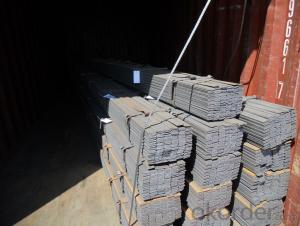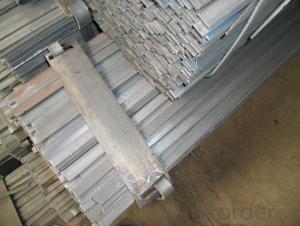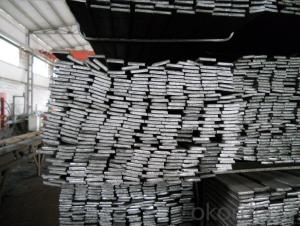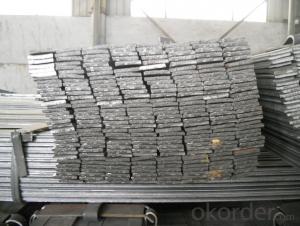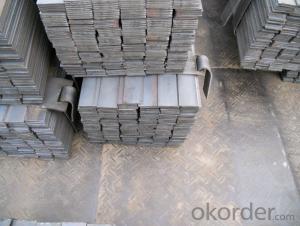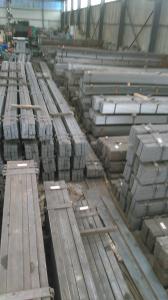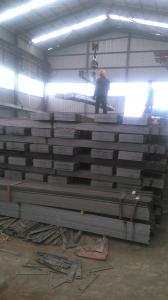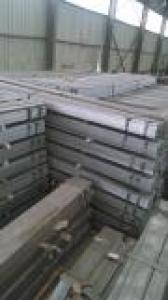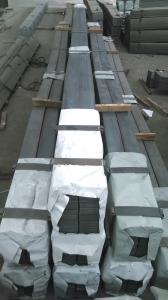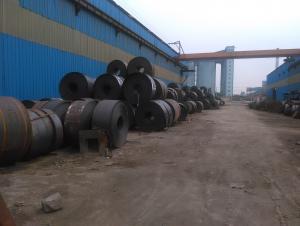GB Standard Steel Flat Bar with High Quality 70mm
- Loading Port:
- Tianjin
- Payment Terms:
- TT OR LC
- Min Order Qty:
- 25 m.t
- Supply Capability:
- 15000 m.t/month
OKorder Service Pledge
OKorder Financial Service
You Might Also Like
Product Description of GB Standard Steel Flat Bar with High Quality 70mm:
Specification of GB Standard Steel Flat Bar with High Quality 70mm:
-Standard: GB
-Material: Q235
-Length: 6m, 12m
-Size:
| Size(mm) | Mass(Kg/m) |
| 70*5 | 2.75 |
| 70*6 | 3.30 |
| 70*8 | 4.40 |
| 70*10 | 5.50 |
| 70*12 | 6.59 |
Package & Delivery of GB Standard Steel Flat Bar with High Quality 70mm:
1.The steel flat bars will be packed in bundle with steel wire at each end of every bundle and color marking in order to help the customer to recognize his goods more easily at sight.
2. And the steel flat bars could be loaded into 20ft or 40ft container, or by bulk cargo. If the weight of each bundle reaches more than 3.5 mt, the loading by break bulk cargo should be choosed. When the weight of each bundle reaches less than 3mt, the loading by container should be choosed.
3.As for the transportaion from mill to loading port, the truck will be usually used. And the maximum quantity for each truck is 40mt.
4.All in all, we could do in accordance with customer's request.
FAQ:
Q1: Why buy Materials & Equipment from OKorder.com?
A1: All products offered by OKorder.com are carefully selected from China's most reliable manufacturing enterprises. Through its ISO certifications, OKorder.com adheres to the highest standards and a commitment to supply chain safety and customer satisfaction.
Q2: How do we guarantee the quality of our products?
A2: We have established an advanced quality management system which conducts strict quality tests at every step, from raw materials to the final product. At the same time, we provide extensive follow-up service assurances as required.
Q3: How soon can we receive the product after purchase?
A3: Within three days of placing an order, we will arrange production. The shipping date is dependent upon the quatity, how many sizes you want and the plan of production, but is typically 1 month to 2 month days from the beginning of production.
Images of GB Standard Steel Flat Bar with High Quality 70mm:

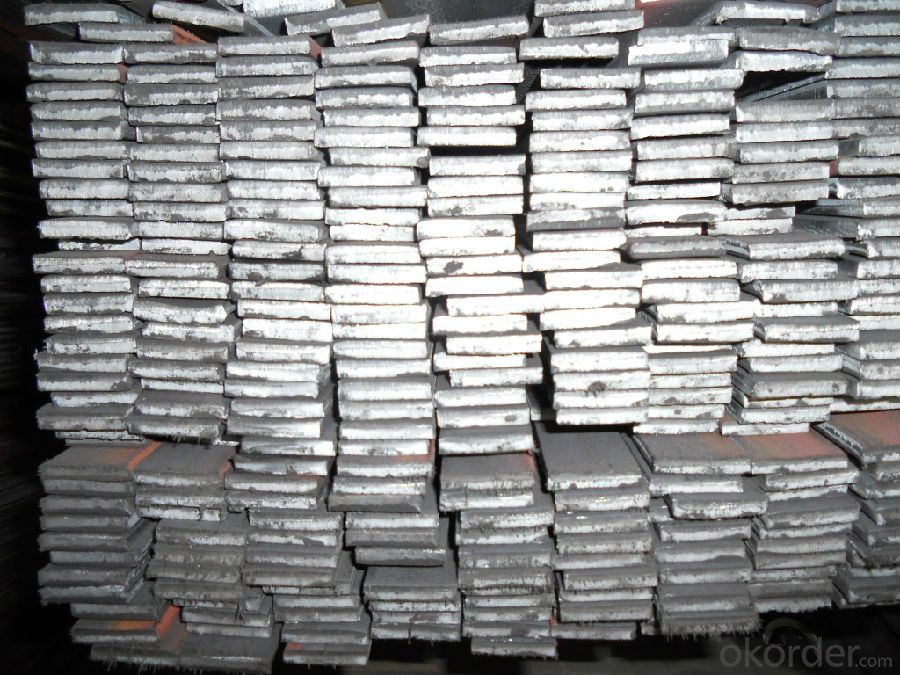
*If you would like to get our price, please inform us the size, standard/material and quantity. Thank you very much for your attention.
- Q: Are steel flat bars suitable for load-bearing structures?
- Indeed, load-bearing structures can indeed be constructed using steel flat bars. The reputation of steel, which is renowned for its remarkable strength and durability, renders it an exceptional material choice for constructing load-bearing structures. Construction projects frequently employ steel flat bars due to their superior support and stability. These bars are deliberately engineered to withstand substantial loads and distribute weight evenly, thereby guaranteeing their dependability for load-bearing purposes. Furthermore, the versatility of steel flat bars allows for easy fabrication and customization to cater to the specific requirements of a given structure. In conclusion, the strength, durability, and adaptability of steel flat bars render them an immensely popular option for load-bearing structures.
- Q: What are the different heat treatment processes for steel flat bars?
- Steel flat bars can undergo different heat treatment processes to enhance their mechanical properties and overall performance. Some commonly used processes for steel flat bars include: 1. Annealing: By heating the steel flat bar to a specific temperature and slowly cooling it to room temperature, internal stresses are relieved, ductility is increased, and machinability is improved. 2. Normalizing: This process involves heating the steel flat bar above its critical range and allowing it to cool in air. Normalizing refines the grain structure, improves mechanical properties, and enhances overall toughness. 3. Quenching and tempering: In this two-step process, the steel flat bar is rapidly cooled in a liquid medium, such as oil or water, to achieve high hardness. This is followed by reheating the quenched steel to a lower temperature to reduce brittleness and improve toughness. 4. Case hardening: Also known as carburizing, this process involves heating the steel flat bar in a carbon-rich environment to add carbon to the surface. Case hardening creates a hard outer layer while maintaining a softer and more ductile core, enhancing wear resistance and providing a tough surface. 5. Stress relieving: This process is used to reduce residual stresses in the steel flat bar that may have accumulated during manufacturing or other processes. By heating the steel to a specific temperature and allowing it to cool slowly, stress relieving minimizes distortion and improves dimensional stability. These heat treatment processes can be customized to meet specific requirements and desired mechanical properties, making steel flat bars suitable for various applications in different industries.
- Q: How do steel flat bars perform in high-temperature environments?
- Steel flat bars generally perform well in high-temperature environments due to their high melting point and thermal stability. These bars can maintain their structural integrity and dimensional stability, exhibiting minimal deformation or weakening even at elevated temperatures. However, prolonged exposure to extremely high temperatures can lead to a reduction in strength and potential oxidation. Therefore, it is important to consider the specific steel grade and its intended application when assessing performance in high-temperature environments.
- Q: Can steel flat bars be used for manufacturing appliances?
- Certainly! Steel flat bars are suitable for the production of appliances. Steel, known for its versatility and durability, is frequently utilized in appliance manufacturing because of its strength and ability to resist corrosion. There are numerous uses for steel flat bars in appliance production, including forming the structure, offering support, and constructing brackets and frames. The flat shape of these bars enables effortless fabrication and shaping, rendering them appropriate for a variety of appliance designs. Moreover, steel flat bars can be conveniently welded or joined together, making them an advantageous option for appliance manufacturing.
- Q: Can steel flat bars be used for making brackets or supports for telecommunications equipment?
- Certainly! Steel flat bars have the capacity to serve as brackets or supports for telecommunications equipment. Steel, being a robust and long-lasting material, can effectively supply the required structural support for such equipment. Flat bars are especially well-suited for this purpose due to their malleability, allowing them to be easily fabricated and molded into the desired bracket or support design. Furthermore, steel flat bars possess outstanding load-bearing capabilities, enabling them to bear the weight and guarantee the stability of the equipment. Moreover, steel exhibits resistance to environmental factors like corrosion and can endure harsh conditions, rendering it a dependable option for brackets or supports in telecommunications equipment.
- Q: How do steel flat bars contribute to the overall efficiency of industrial structures?
- Steel flat bars contribute to the overall efficiency of industrial structures in several ways. First and foremost, their durability and strength make them an ideal choice for structural components. Steel flat bars are known for their high tensile strength, which means they can withstand heavy loads and provide structural stability. This strength allows for the construction of taller and more complex industrial structures that can house various equipment and machinery. Furthermore, steel flat bars are highly versatile and can be easily fabricated, cut, and welded to fit specific design requirements. This flexibility enables engineers and architects to create customized industrial structures that maximize space utilization and optimize workflow. Whether used as support beams, braces, or reinforcements, steel flat bars can be tailored to meet the specific needs of a project, reducing construction time and costs. In addition, steel flat bars are resistant to corrosion and can withstand extreme weather conditions, making them suitable for both indoor and outdoor industrial structures. This resistance ensures longevity and reduces the need for frequent maintenance, saving both time and money in the long run. Moreover, steel flat bars are readily available and cost-effective compared to other materials. Their widespread availability and standardized sizes make procurement and construction processes more efficient, resulting in shorter lead times. This accessibility also allows for easy repairs and modifications, ensuring that industrial structures can adapt to changing needs and technologies without significant disruptions. Overall, steel flat bars contribute to the efficiency of industrial structures by providing strength, versatility, durability, and cost-effectiveness. Their usage enhances the structural integrity of buildings, optimizes space utilization, reduces maintenance requirements, and allows for easy customization. As a result, steel flat bars play a crucial role in the construction of efficient and reliable industrial structures.
- Q: How do steel flat bars compare to glass flat bars?
- Steel flat bars and glass flat bars are two very different materials with distinct characteristics and uses. Steel flat bars are made from steel, a strong and durable metal alloy. They are commonly used in construction, manufacturing, and industrial applications. Steel flat bars offer high tensile strength, excellent load-bearing capacity, and resistance to corrosion. They can withstand heavy loads and are suitable for structural support, reinforcement, and framing. Steel flat bars are also versatile and can be easily welded, bent, or fabricated to meet specific project requirements. Additionally, steel flat bars are available in different sizes, thicknesses, and finishes, providing flexibility in design and construction. On the other hand, glass flat bars are made from glass, a brittle and transparent material. Glass flat bars are primarily used in architectural and decorative applications, such as for glass balustrades, partitions, shelving, or display fixtures. Glass flat bars provide a sleek and modern aesthetic, allowing for the passage of light and creating an open and airy feel. They are available in various colors, textures, and thicknesses, enabling customization and design creativity. However, glass flat bars have limited load-bearing capacity compared to steel, making them unsuitable for heavy structural or industrial applications. In summary, steel flat bars are known for their strength, durability, and versatility, making them ideal for structural and industrial purposes. Glass flat bars, on the other hand, offer a unique aesthetic appeal and are commonly used in architectural and decorative applications. The choice between steel and glass flat bars depends on the specific requirements of the project, including load-bearing needs, design preferences, and intended application.
- Q: Can steel flat bars be used in the construction of bridges?
- Certainly! Steel flat bars are capable of being utilized in the construction of bridges. The utilization of steel in bridge construction is prevalent due to its superior strength, durability, and capacity to endure substantial loads. In bridge construction, steel flat bars frequently serve as structural elements, particularly for beams, girders, and piers. They offer exceptional support and stability, enabling bridges to cover vast distances and accommodate heavy traffic loads. Moreover, steel flat bars can be tailored and manufactured to specific dimensions and configurations, rendering them versatile and suitable for diverse bridge designs. In essence, steel flat bars are an indispensable constituent in bridge construction, contributing to the fortitude, safety, and longevity of these structures.
- Q: Can steel flat bars be used in architectural applications?
- Yes, steel flat bars can be used in architectural applications. They are often used for structural support, framing, and decorative purposes in building designs. Steel flat bars offer durability, strength, and versatility, making them suitable for various architectural applications such as railings, stairs, window frames, and facades.
- Q: Can steel flat bars be used for agricultural applications?
- Yes, steel flat bars can be used for agricultural applications. Steel is known for its strength and durability, making it suitable for various agricultural tasks. Steel flat bars can be used for constructing fences, gates, and livestock enclosures, providing a sturdy and long-lasting solution. They can also be used as support beams or braces for structures like barns or sheds. Additionally, steel flat bars can be used for creating custom implements or machinery parts, such as plow blades or cultivator tines. Overall, steel flat bars offer the necessary strength and versatility required for agricultural applications.
Send your message to us
GB Standard Steel Flat Bar with High Quality 70mm
- Loading Port:
- Tianjin
- Payment Terms:
- TT OR LC
- Min Order Qty:
- 25 m.t
- Supply Capability:
- 15000 m.t/month
OKorder Service Pledge
OKorder Financial Service
Similar products
Hot products
Hot Searches
Related keywords
